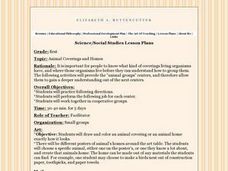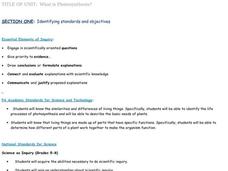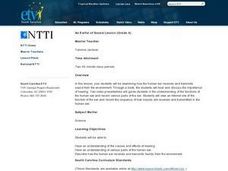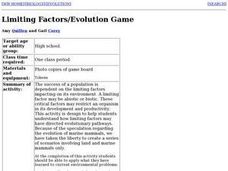Curated OER
Amphibians
Fourth graders Make flashcards for the following words, memorize them and get quizzed by the teacher: Amphibian, Lungs, complete metamorphosis, tadpoles, tail-less, tail, vertebrate, cold-blooded, gills, swamp, pond.
Curated OER
Cell physiology and chemistry
Students design an experiment to discriminate between chemical diffusion, osmosis, facilitated diffusion and active transport through a membrane. Be specific about predictions and interpretations!
Curated OER
Extensions - Biology Review Unit
Students engage in a variety of activities in order to review a Biology unit. For example, they research the Bird Flu, it's history, how it is spread, what has been done about it, what better options exist for controlling or removing it....
Curated OER
Animal Coverings and Homes
First graders research what kind of coverings living organisms have, and where those organisms live before they can understand how to group them. The following activities will precede the "animal groups" centers, and therefore allow them...
Curated OER
Using My Senses
Students observe crickets in the terrarium. Have them record in their journal any evidence of crickets having senses. Then they answer questions like these: How do they use their sense organs? Where are they are located?
Curated OER
What is Photosynthesis?
Students investigate the similarities and differences of living things. Specifically, students will be able to identify the life processes of photosynthesis and describe the basic needs of plants.
Curated OER
RAINFOREST Mini-Unit
Students engage in a variety of activities to investigate the subject of rainforests. The lesson focuses on the different floors of the rainforest and the types of life that exists on each.
Curated OER
VERTEBRATES
Seventh graders describe the main characteristics of warm-blooded vertebrate animals. They compare and contrast the two different groups of warm-blooded vertebrate animals by looking at external, reproductive, and growth characteristics.
Curated OER
Forest Friends Forever
Students investigate how to use the senses to gather information about objects such as size, shape, color, texture, sound, position, and change (qualitative observations are utilized throughout this lesson). They investigate and explain...
Curated OER
Rattle Your Bones and Flex Your Muscles
Third graders identify bones, muscles and joints. They explore and investigate the interaction between bones, muscles and joints, and movement of the hand or foot. To help the teacher provides a poster of the human skeleton.
Curated OER
Sun Seeking Plants
Pupils investigate the story "The Tiny Seed" by Eric Carle. This story is used to introduce the children to the concept that seeds change and grow into plants when conditions in the environment including temperature, light, water and...
Curated OER
Cell-ebrations in Science
Students recognize that all living things are made up of cell and that they cannot easily be seen by the naked eye. Students become familiar with the use of microscopes as a tool for investigation.
Curated OER
Scientific Inquiry
Students investigate the general geology, biology, and chemistry of Seneca Lake. They study how to use scientific instruments on the research vessel. They explain how the data they gather will be used by scientists and develop a hypothesis.
Curated OER
An Earful of Sound Lesson
Fourth graders examine how the human ear receives and transmits sound from the environment. Through a book, they hear and discuss the importance of hearing. Students view an Internet site of the function of the ear and record the...
Curated OER
Science NetLinks: Burrowing Owls
Students investigate the example of the burrowing owl to illustrate how human activities can control the fate of species. The research is focused on the ecosystem and examining the different species within it.
Curated OER
Science NetLinks: Changing World 1: Endocrine Disruptors
Students investigate how environmental surprises and endocrine disruptors influence perceptions of benefits and costs. The decisions of science are under these type of influences and must be thought out with a definite method.
Curated OER
Science NetLinks: Fossils and Geologic Time
Students investigate the development of the geologic time scale. Also, to introduce them to the major time periods in earth's history, as well as to the role fossils play in helping us understand this history.
Curated OER
Self-Assessment
Students take a personal inventory about behaviors. They determine if there are risky behaviors present that could be harmful. The inventory is used to help students examine how to make healthy decisions.
Curated OER
Signs of the Seasons
Students closely observe the natural world, record data, and notice patterns as the seasons unfold, they build a deeper understanding of seasonal change! The definition of phonology is the focus of this activity and how it changes...
Curated OER
The Structure of DNA
Students will demonstrate knowledge of the structure of DNA by constructing simple models of DNA with materials given to them in class. They will also discover that some female scientists such as Rosalind Franklin have not been given...
Curated OER
Life Cycle Literature Briefs
Literature containing life cycle information is available from many sources. Several examples of this type of literature are listed below with a synopsis and sample questions for each. These examples have been taken from a variety of...
Curated OER
Gametogenesis and Fertilization
High schoolers explore how this module focuses on part of the cycle of alternation of generations: meiosis to produce haploid spores and fertilization to produce a diploid zygote which grows into the adult plant.
Curated OER
Modeling Allele Distribution Through Meiosis and Fertilization
The main objective of this activity is to illustrate the variation that results from crossing-over during prophase I of meiosis. Other sources of variation from generation to generation are: (1) independent assortment (223 possible...
Curated OER
Limiting Factors/ Evolution Game
Students will understand the relationship between limiting factors and evolution. They will be able to hypothesize possible evolutionary pathways for modern day organisms.

























